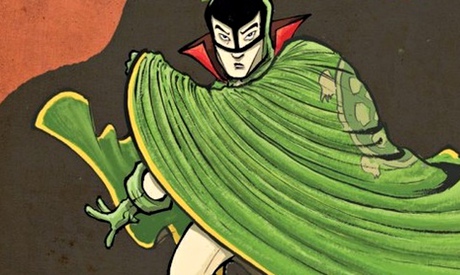
While the debate around the extent to which a female Thor and a black Captain America will boost diversity in comics continues, Gene Yang and Sonny Liew last week released The Shadow Hero, their 176-page book narrating the origins of the first Asian American superhero: The Green Turtle. If the name is unfamiliar, it's because the story of the Green Turtle is one of those strange, cult tales that the medium seems to regularly harbour, complete with underdog and a dash of intrigue.
In 1944, Chinese artist Chu F Hing, tasked with creating a new superhero, bought to life the Green Turtle. Adorned with a green skullcap, mask and cape emblazoned with a large turtle, he whizzed around Asia protecting people from the occupation forces of the Imperial Japanese Army. The story goes that Hing was keen to make the character Asian American, a request that was – perhaps unsurprisingly – refused by his bosses, 1940s society not being ready for a non-white hero. The resultant comic, however, gave birth to a myth of its own.
In the five issues for which the comic ran, Hing went to great lengths to obscure the Green Turtle's face; using objects and figures to hide his profile, positioning him with his back to the reader, the effect pronounced by the angles employed. It is clearly a deliberate artistic choice, the most popular interpretation of which is that, displeased with his editor's decision, Hing decided that if his character couldn't be openly Asian, then in time-honoured superhero tradition, he would be covertly so.
The story of Hing's rebellion has captivated those aware of it, including award-winning author Gene Yang: "I was fascinated by the possibility of an Asian American superhero during the Golden Age. There was something very affirming about it, you know? Superheroes are so American, and Asian Americans sometimes struggle with the perception of foreignness, of never really belonging. To think that this old, old character might be one of us … It got to me."
With the Green Turtle having long since fallen into public domain, Yang decided to collaborate with Eisner-nominated artist Sonny Liew to provide Hing's hero with the origins story he had never received. "I didn't want to do a modern day story," says Yang. "The whole point was to show that at least one Asian American superhero was there, from the beginning."
The Shadow Hero transports the reader to 1940s America where Hank, a young Chinese American, the son of immigrants, is content working at his father's grocery store, until events – some natural, some less so – lead him to don the mantle of the Green Turtle. The book is a coming of age tale, loving homage to Golden Age superheroes and moving family drama – all wrapped in a surprisingly acute depiction of the immigrant experience. There's the loss of identity Hank's mother experiences, his father's refusal to move beyond the familiar, Hank's own struggle to find a place and meaning of his own. Fizzing with humour, and a characterful charm lent to it by Liew's expressive, nuanced lines, it's a genuinely refreshing inclusion to the oeuvre.
The book comes complete with a reprinted issue of Hing's comic, and there's a knowing nod to his efforts when Hank makes his first outing as the Green Turtle, and Liew delightfully replicates the obscured angles of the original. That was the least of the visual challenges presented : "The main thing I worked on was figuring out how to draw the characters – to be recognisably Asian without being a caricature – which was an issue with a lot of Golden Age comics. Even in The Green Turtle, Hing would draw what were pretty racist versions of Japanese soldiers. I looked at Milton Caniff's work, and there, too, the narrow eyes felt a little exaggerated – but then cartooning is often about exaggeration, so it's a tricky line to walk, especially so because with comics a lot of styles rely on visual shorthands, so it's easier to slide into caricature."
Both a revival and a celebration, The Shadow Hero is ostensibly a story of place and belonging; an association Yang believes is a natural fit for the genre. "Dual identities, having to hide a part of who you are, living under two different sets of rules: those were daily realities for immigrants and their children. We want to relate to our culture the way fish relate to water – we don't want to have to think about it. I hoped, that by bringing the immigrant experience subtext to the forefront, Sonny and I would be able to tell a story that was both familiar and fresh."

